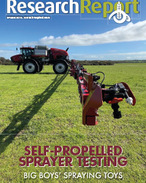This article is 8 years old. Images might not display.
Hard to kill species such as fleabane, sowthistle, feather top Rhodes grass and skeleton weed that have a natural tolerance to herbicides are popping up across farms Australia more and more frequently. These weeds often have hairy surfaces, thick cuticles and reduced translocation due to plant stress or internal mechanisms that metabolise herbicides.
Spray application consultant with Nufarm Australia, Bill Gordon, said the application rate and technique are critical when managing these weeds.
"If the application is compromised there is a good chance that the weed will survive and go on to set seed," Gordon said.
"With weeds that are generally susceptible to a herbicide's mode of action we see low dose rates inadvertently applied through insufficient coverage, incorrect formulation or adjuvant choice and stressed plant condition, which all impact on the uptake of the herbicide," he said.
Gordon said the choice of droplet size, carrier volume and sprayer setup all contribute to the delivery and effective uptake of the herbicide.
"If a population of susceptible weeds are exposed to long-term low dose application there is strong selection for plants that can survive and set seed, leading to increased herbicide resistance over time," Gordon said.
"Correct plant identification and knowing the resistance status of the population is key to choosing the most appropriate product, most effective rates and the recommended adjuvant," he said.
"Water is the cheapest thing that goes in the spray tank so use sufficient total application volumes to achieve the coverage required for the mode of action group, particularly in paddocks with plenty of stubble."
According to Nufarm,** common spray application mistakes that can contribute to herbicide resistance include mismatching rates, application volumes and not rotating modes of action.
"Application technique and the choice of product, rate, water volume and adjuvant are generally within the grower's control. Weather conditions and the plant size and stress are harder to work around. In ideal conditions the aim is to apply the right rate of the right product to the right target to achieve plant death and prevent seed set. Herbicide resistance is known to evolve, often un-noticed, along fence lines and other green bridge situations," Gordon said.
Gordon said to counteract the edge effect, ensure the correct dose rates on paddock borders.
"Maintain wide enough headlands to allow easy turning and entering the paddock with the full spray pressure. Using a minimum hold in the controller for non-residual products will prevent the rate dropping too low and ensure the nozzle's spray pattern does not collapse. For residuals, slow down and increase application volume to minimise overdosing that may impact on crop establishment, or increase plant back periods," Gordon said.























